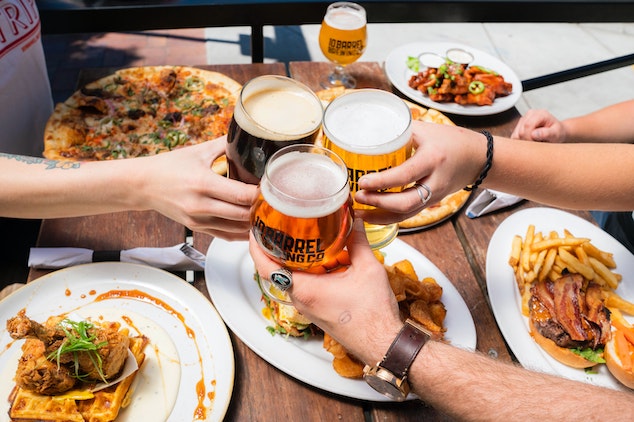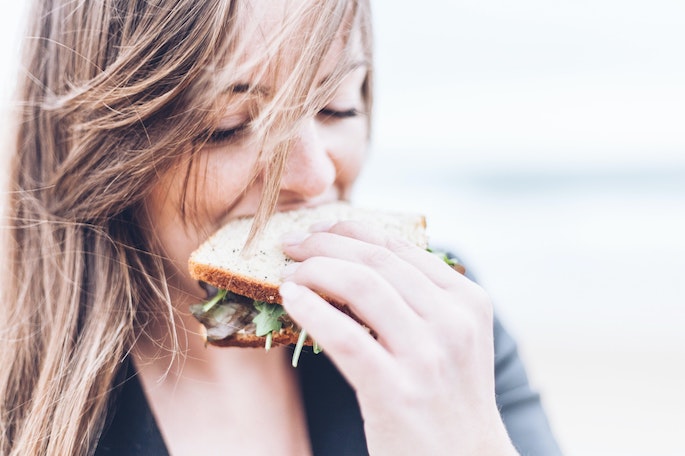There have been so many discussions about mindful eating online in the past few years. The phrase “mindful eating” feels like a new fancy term after “CICO diet” that was also overly marketed even though they mean very different things. “Mindful eating” sounds sophisticated, philosophical, and feels liberating. However, most people I know, after reading tons of theories and discussions around this topic, are still confused about where they can start after years of dieting. Therefore, in this article, I’d like to share one simple and practical mindful eating exercise, which you can start using now to slow down and stop the over-indulgence pattern without waiting.
First, what is mindful eating?
Mindful eating is being present with yourself and the moment when eating, enjoying food without judging or overthinking, with the unconscious consciousness of eating the right kind and amount of food, and being in control without trying to control anything.
In fact, if you’ve read other articles about mindful eating written by western writers, you’d realize this definition I’ve given above is different by nature from what they have said. And here’s what you are usually told as the definition of “mindful eating:”
“Mindful eating focuses on your eating experiences, body-related sensations, and thoughts and feelings about food, with heightened awareness and without judgment. Attention is paid to the foods being chosen, internal and external physical cues, and your responses to those cues.” (Source).
The keywords of my definition is “present with yourself and the moment” and “unconsciously conscious.” The gists in the other definition is focusing on eating and paying attention to food.
As a weight loss and eating specialist from Asia who has turned frustrated dieters into relaxed mindful eaters for 8 years, when seeing how the originally Asian concept of ‘mindfulness’ is translated in the western world, I can always see the distortion.
The Truth:
The truth is: mindful eating isn’t really about focusing on food. Instead, it’s about being present and fully immersed in the MOMENT that comprises so much more, which food and the act of eating is a part of. The moment is far beyond the act of eating alone — the people you are sitting with, the music in the room, the beautiful plate set, the conversation that’s ongoing, and the purpose of you being there, etc.
In Asia, we’ve learned about mindful eating at a very young age. But it’s never about watching the food and thinking of food from the beginning to the end. The key is: you are present in the moment while being subconsciously aware of food without being fixated on the thoughts of it. It’s happening subconsciously. It means there’s no deliberation seen. And that’s why it’s an ‘unconsciously conscious’ process.
By contrast, in western countries, mindful eating is mainly introduced as a methodology to counter overeating. The mainstream idea of it still involves watching, feeling, sensing, and thinking of food during the process of eating. Still, the moment revolves around food. And food is the center of attention from the beginning to the end.
The Gap:
Although this idea may sound logical and well-meaning in helping people apply better self-control, it’s risky because it can mislead you into believing that in order to eat healthy, you have to watch food closely every time they eat. This alone blocks food freedom. And it trigger constant overthinking about food, which is not what you want.
So, real mindful eating is rather an unconscious conscious process. There’s not much thought process about food going on at all. But you are subconsciously aware of the choice you are going to make because your brain and body have everything in control — with your core senses and systems performing their jobs as they should.
And that leads to the following domino fact about mindful eating.

Mindful eating is an instinct.
It might sound surprising or remotely understandable to you if you’ve always held the belief that mindless eating is your default.
To help you connect to that idea, let me ask you a few questions:
When was the last time you had to count the seconds of your breathing to know that you aren’t overly inhaling oxygen?
And when was the last time you had to count the inches between your feet when walking — to make sure you aren’t going to step on yourself?
Walking. Breathing. Eating.
These are BASIC SURVIVAL INSTINCTS that keep us alive with the perfect balance in each of them inherently granted and navigated by your brain and body. If you aren’t counting steps and seconds for walking and breathing, what makes you think you have to count calories to make sure you aren’t overeating?
Our body has its neurological system, core physical senses, and the hormonal, metabolic, and digestive mechanisms that are built to help us reach the balance we need.
The key takeaway: mindful eating isn’t a new skill to learn, but a dormant ability to wake up.
What’s stopping you from mindful eating towards health and balance?
So mindful eating is your instinct. But what has been preventing you from using it? Years of self-deprivation and dieting.
Here are the 3 mainbarriers brought along by the dieting experience, which will forever be in your way if left unresolved:
- #1. You haven’t found your real point of satiety. It means you aren’t sensing the fullness signals sent by your body accurately and on time. This disconnection primes you to either overeat or undereat. And naturally, you will have to rely on exhausting counting mechanisms and live on diets — to avoid overeating. And it’s especially the case for people who have been dieting for so long that they don’t even remember what fullness feels like.
- #2. Your taste buds are wired to prefer the wrong kinds of food all the time. It means you’ll always crave the sugary, salty, and processed food — not because they are delicious by default, but that your mind is trained to like them and think of them as delicious. (Side note: you’d be surprised to know how many people, after they’ve reverted this problem, find some of their old addiction unpleasant and even intolerable.)
- #3. You can’t sever your mind from the craving triggers, and your body is trained to act on the triggers all the time. This means you always lose self-control.
When you have these problems, your mind and body are physically and chemically programmed to make you overeat and eat unhealthily. And this stops you from eating intuitively, reliably, and relaxingly.
Emotionally it’s also very tough for you. This is because deep in mind you’ll always have the belief that food is your enemy and it makes you fat — even though it’s how you are programmed that leads you to gain weight. In line with that, you don’t believe you’ll ever be able to lose weight without dieting. It means you can’t trust food or your ability to stay in control with it. And you might even be obsessed with food because the more you are deprived of food, the more you think about it. Mindful eating CAN’T happen when you are living on the dimension of insecurity, anxiety, and fears.
A Simple Mindful Eating Exercise That Stops Over-Indulgence:
Despite the challenges listed above, you can still start practicing mindful eating. You may start low due to these gaps mentioned, but the more you practice, the more you’ll get a hold of it.
First, one caution and one principle for you to grasp:
If you find mindful eating exercise online, you can find tons of results around it. However, 99% of these exercises won’t help you at all. This is because they are made way too complicated. And sometimes the writers don’t really know much truth about this topic themselves. Mind you, a lot of the content is created by bloggers and ghost writers instead of experts and specialists. And the principle here is that complication contradicts the very nature of eating, which is intuitiveness and simplicity.
Mindful eating is an instinct after all, remember?
So, if I ask you to remember 10 steps and 5 rules when eating, I’m not teaching you mindful eating. Instead, I’m teaching you food overthinking and creating resistance and confusion about the idea of mindful eating even before you fully accept it.
Hence, here’s a very simple exercise that’ll change your eating experience. The steps are simple, but be attentive about the nuances and subtleties in the description of the steps.
Scenario 1. Eating A Donut (And Stoping At A Few Bites).
In this scenario, you are eating a donut, and you want to stop feeling the craving and put it down easily as soon as you’ve satisfied yourself.
- Step 1. Eat a bite of the donut, slowly, and feel the donut while chewing. What’s the flavor? What’s the texture like? Feel satisfied? No need to overthink and ask yourself 10 different questions, just stop at these 3. Do not rush the process, let the feeling of satisfaction sink in for a few secs. If it’s enjoyable, it’s important to acknowledge that you are enjoying it because satisfaction leads to closure.
- Step 2. After you’ve finished that bite, take a pause, and ask your inner self (imagine a small kid living in your mind) “have you had enough?”
- Step 3. If your inner self answers “yes,” stop, and it should be easy because your mind has acknowledged you’ve had enough already. MOVE ON and transfer your attention back to the MOMENT (see definition of ‘moment’ in the opening paragraphs). However, if the answer is “no,” have another bite, and repeat Step 2.
In Step 1, you feel the food because you want to authentically experience it — to know if it’s enjoyable and enough later. Psychologically, acknowledging you’ve enjoyed the food helps you realize that you’ve been satisfied, which is the key to being able to stop. As I said earlier, it’s satisfaction that leads to closure just like it’s self-deprivation that leads to obsession and over-indulgence.
In Step 2, you ask your inner self this question “have you had enough?” because now you are making yourself aware of your true need, respectfully, like how you’d treat a dear friend. And because you are understanding and caring, the inner self is likely to give you a sensible and honest answer..
That’s it.
The key is treating yourself with authenticity, self-care, and respect. And respect isn’t about allowing yourself to overly indulge. It’s about being sensible, caring, and asking the right questions then attentively listening. And once you’ve done that, sit back and watch the cascading effect.
Scenario 2. Having A Big Holiday Dinner (And Don’t Want To Overeat).
Let’s say you are having a big dinner with your family and you want to stop right before overeating:
- Step 1. Take a bite of what you have on your plate, slowly, and feel the texture and flavor of the food. Same as before, let the feeling of the food sink in. And if the food is good, acknowledge the enjoyment. In this case, also sense how your stomach feels — is it full? Is it half full? Is it 80% full? Try to connect to the feeling as much as possible. I know for some people it’s challenging because they’ve already forgotten what fullness is like. Don’t let that hold you back. Just try yourself to connect with that physical sense by visualizing how your stomach is feeling right now.
- Step 2. Now ask your inner self “have you had enough?”
- Step 3. If the answer is “yes,” stop. If not, have one more bite, and ask yourself again.
As you can see, the logic is quite the same with the first example except for the physical sense part. This is because you want to stay connected with your sense of fullness.
Repeat this mindful eating exercise once and once again until it becomes a subconscious thing that starts itself every time. Remember I mentioned at the beginning that mindful eating is an unconsciously conscious move? Eventually, the dialogue will become more and more intuitive and subtle. And it just happens at the back of your mind and reaches the decision without you being aware of the process. No overthinking. No judgement. That’s what mindful eating is about — seemingly mindless even because it’s an instinct already.
Frankly speaking, this mindful eating exercise above is not going to make you master mindful eating overnight. But it’s a great starting point. It’s simple enough to apply every time. And it’ll help you become more and more aware of what your body really needs.
It means you won’t just keep overeating the wrong things for that moment. And this is the first milestone that you must attain if you want to fully master mindful eating.
So how do I fully master mindful eating?
Fully mastering mindful eating requires two things:
- Systematically rewriting the inner patterns about how you view, sense, feel, process, and experience food;
- Removing mental blocks including beliefs within you that create fear and insecurity about food. The psychology part is essential to transforming your relationship with food. In order to gain food freedom, you need to believe and see that food isn’t a barrier to health and weight loss.
What I’m referring here is a full-stack, holistic experience that teaches you to eat mindfully, reconnect to the latent core senses, reset how your body functions, and most importantly, enables you to embrace satisfaction and unlimited food freedom while achieving your weight goal.
Being able to accomplish a healthy weight is important to mindful eating. This is because it shifts your belief about food and eating fundamentally. The truth is you can accomplish food freedom while losing weight (I’ve been helping people do this for 8 years!) By trusting food and your body again, you’ll trust mindful eating process and master it.
Leslie Chen is Creator of Lean Instinct Formula™, which helps people enjoy UNLIMITED food freedom while gaining a head-turning body — through re-writing their physical and emotional patterns towards eating, removing their inner weight loss blockers, jumping out of the western FAD labyrinth, and leveraging Asian wisdom that creates immediate organic results. Leslie is rated as one of the Top Weight Loss Coach in by Coach Foundation due to consistent results she brings to her clients. Want to work with Leslie? Book a Clarity Call.


